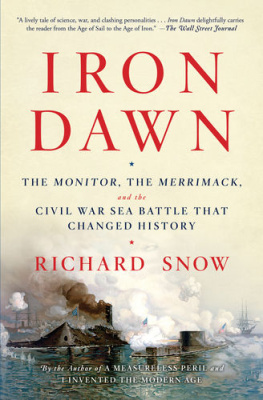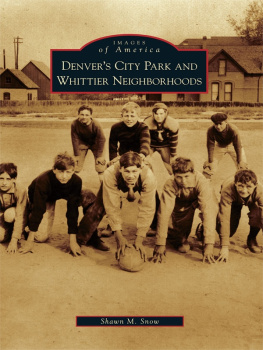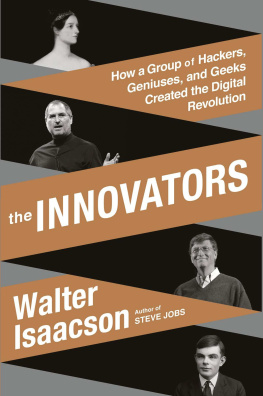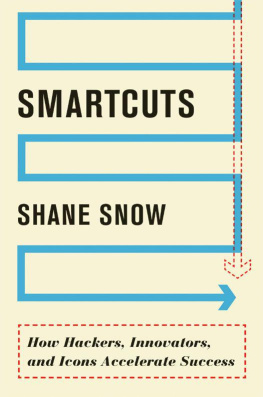Snow - Smartcuts how hackers, innovators, and icons accelerate success
Here you can read online Snow - Smartcuts how hackers, innovators, and icons accelerate success full text of the book (entire story) in english for free. Download pdf and epub, get meaning, cover and reviews about this ebook. City: New York;NY, year: 2014, publisher: HarperCollins;Harper Business, genre: Romance novel. Description of the work, (preface) as well as reviews are available. Best literature library LitArk.com created for fans of good reading and offers a wide selection of genres:
Romance novel
Science fiction
Adventure
Detective
Science
History
Home and family
Prose
Art
Politics
Computer
Non-fiction
Religion
Business
Children
Humor
Choose a favorite category and find really read worthwhile books. Enjoy immersion in the world of imagination, feel the emotions of the characters or learn something new for yourself, make an fascinating discovery.
- Book:Smartcuts how hackers, innovators, and icons accelerate success
- Author:
- Publisher:HarperCollins;Harper Business
- Genre:
- Year:2014
- City:New York;NY
- Rating:5 / 5
- Favourites:Add to favourites
- Your mark:
- 100
- 1
- 2
- 3
- 4
- 5
Smartcuts how hackers, innovators, and icons accelerate success: summary, description and annotation
We offer to read an annotation, description, summary or preface (depends on what the author of the book "Smartcuts how hackers, innovators, and icons accelerate success" wrote himself). If you haven't found the necessary information about the book — write in the comments, we will try to find it.
Snow: author's other books
Who wrote Smartcuts how hackers, innovators, and icons accelerate success? Find out the surname, the name of the author of the book and a list of all author's works by series.
Smartcuts how hackers, innovators, and icons accelerate success — read online for free the complete book (whole text) full work
Below is the text of the book, divided by pages. System saving the place of the last page read, allows you to conveniently read the book "Smartcuts how hackers, innovators, and icons accelerate success" online for free, without having to search again every time where you left off. Put a bookmark, and you can go to the page where you finished reading at any time.
Font size:
Interval:
Bookmark:
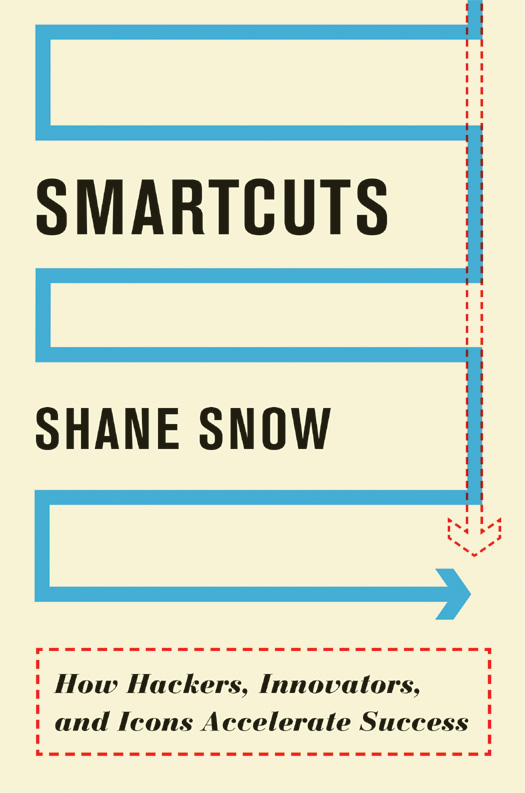
CONTENTS
I.
A strange thing has been happening in the United States for nearly 300 years. For some reason, our presidents are younger than our senators.
The average president of the United States takes office at age 55. In contrast, US senators start their terms in Congressthe most recent at the time of this writingat an average of age 62. Members of the House of Representatives were 57.
This is not a recent anomaly. Presidents have tended to be younger than Congress since the Founding Fathers died. And though a handful began the job as senior citizens, the average starting age has never crossed 60.
These statistics are especially peculiar because of how much more difficult it is to become president than a senator. Terms in the Senate are commonly seen as a step on the path to president. But even brand-new senators, holding their first federal office ever, have been coming in at an average of 56 and 57 in recent years. Presidents get to the top before senators get in the door.
Why?
Armchair explanations like good looks dont make sense. Why would we be more likely to vote for a handsome young president but not a good-looking young congressperson? Data in presidential versus congressional elections indicates that youth voter turnout isnt the culprit.
Some sort of creeping mistrust of the elderly or the advent of televised elections arent skewing the results, either. The oldest-elected president, Ronald Reagan, took office at age 69, with the fourth-oldest, George H. W. Bush, succeeding him at 64. They brought up the average. Gerrymandering and changing campaign finance laws dont seem to explain the data, and the losers in presidential elections actually tend to be the same average age as the winners.
Weve had rich presidents, poor presidents, political-insider presidents, Washington-outsider presidents, pretty presidents, ugly presidents, eloquent presidents, stammering presidents, old presidents, and young presidents. But mostly young presidents.
Lyndon B. Johnson became president at exactly 55. Perhaps his story will give us a clue to the phenomenon.
Born on a farm in Texas, Johnson was always a talker. He first ran for president in 11th grade. He won. Described by peers as ambitious from the beginning, he got involved in adult politics shortly after high school. He first served as a legislative secretary to a Texas congressman, but had won his own seat in the US House by age 29. Several terms later, he moved up to the Senate. From junior senator he rose to the rank of majority whip, then minority leader, then majority leader. Having paid his dues in each branch of Congress, he was elected John F. Kennedys vice president in 1960.
Then, tragically, President Kennedy was killed, and LBJ assumed his office, having climbed the political ladder for 25 years.
From the beginning of his career, LBJ was extraordinarily focused. He worked hard, pulled himself up by his own bootstraps, and patiently worked the ladder. And, after all that work, the last stage of his ascent came down to luck. If Kennedy had lived, Vice President Johnson wouldnt have had the chance to run for president until he was in his 60s.
We all know this ladder-climbing story. Its gospel weve preached in career- and business-building for centuries. Were told that the best way to succeed is to start young, work hard, and move up through the ranks. The two ingredients are hard worknot quitting when things get toughand luckspots opening up on the rungs above you. LBJs is that quintessential American story.
The problem is, when we look at the data, LBJs isnt the quintessential presidential story at all.
Only three other presidents out of the 43 people who have been president at the time of this writing climbed the rungs of all four elected federal offices: Richard Nixon, Andrew Johnson, and John Tyler. Just over half of the presidents were ever congressmen at all.
It gets even more interesting when we look at the amount of time these men spent climbing up the political ladder. The ten oldest presidentsthe ones who bring our age average upheld a federal office for nine years, or less than two Senate terms. Lyndon B. Johnsons story would suggest that these older presidents fought their way up the congressional ladder over a quarter century, and just got started a little later. But no.
In fact, most presidents spent just over half as many years in state and federal politics as LBJ did. Ignoring state politics, the average president spent just seven years as an elected official before reaching the White House. Five were never elected to any office before becoming president.
Theres something wrong with the great American ladder-climbing advice: presidents of the United States, some of the worlds most successful people, dont follow it.
Its like each invented his own ladder.
II.
There is a pattern to the unconventional career tracks of US presidents. We find it among other groups as well. Throughout history, fast-rising companies, rock-star executives, overnight movie stars, and top-selling products have outrun their peers by acting more like ladder hackers than ladder climbers.
The best way to explain how that ladder hacking works comes from the Mormons.
RELATIVELY FEW PEOPLE LIVE in the environs of Brigham Young University, out in the American West. Some who do are occasionally surprised by a late-night knock on the front door and a strange request. Not from preachers or salesmen, but from bored Mormon college students.
Mormonsand Mormon schools like BYUhave a health code that discourages alcohol. When you put tens of thousands of young abstainers together in a small college town, an obnoxious proliferation of creative group activities results. One of them is the reason for that late-night knock. Its a game called Bigger or Better.
Bigger or Better is a scavenger hunt, a sort of trick-or-treating for (young) adults. Players divide into teams and begin with a small object, like a toothpick, then disperse and knock on neighborhood doors, one house after another.
At each answered door, the players introduce themselves with something on the order of, Were playing a game called Bigger or Better. Do you have something in your house thats slightly bigger or better than this... (display object)... that you would trade with us?
The first few houses are the toughest. People relaxing at night in their homes arent often searching for toothpicks. Even in the friendly Rocky Mountains a homeowner can be put off by such a request. But before long, a stranger will good-naturedly offer a piece of gum for that toothpick, and the game is on.
At the next house, the gum becomes a ballpoint pen. At the next: a pack of Post-it notes. Then: a copy of last months Nylon magazine. The magazine becomes a bouquet of flowers left by an unwanted admirer. The flowers get swapped for an old hat, and the hat is exchanged for a novelty T-shirt. In this phase of the game, the players benefit from a bit of curiosity, a little charity, and the fact that people were planning on getting rid of most of these objects anyway.
But after enough trades, the players hold objects of significant value in their hands. Now the boy who opens the door sincerely wants the T-shirt. He trades his lava lamp for it. The girls next door like the lava lamp and decide to part with a vintage mirror. The old woman down the street collects antiques; she accepts the mirror in exchange for an old BMX bike in the garage.
When time is up, the players return home to compare results. After a dozen or so trades, teams have turned toothpicks into a stereo system, a set of golf clubs, and a television set. One group even drags in a full-size canoe.
Font size:
Interval:
Bookmark:
Similar books «Smartcuts how hackers, innovators, and icons accelerate success»
Look at similar books to Smartcuts how hackers, innovators, and icons accelerate success. We have selected literature similar in name and meaning in the hope of providing readers with more options to find new, interesting, not yet read works.
Discussion, reviews of the book Smartcuts how hackers, innovators, and icons accelerate success and just readers' own opinions. Leave your comments, write what you think about the work, its meaning or the main characters. Specify what exactly you liked and what you didn't like, and why you think so.



